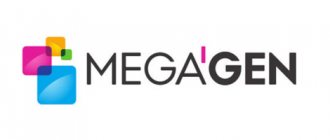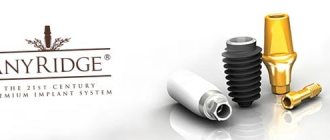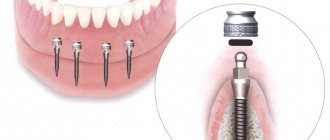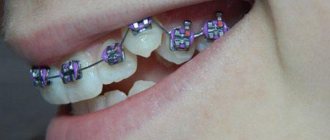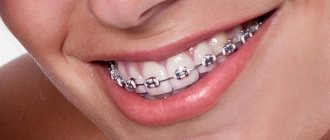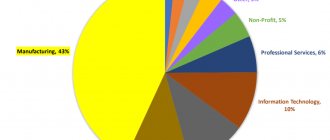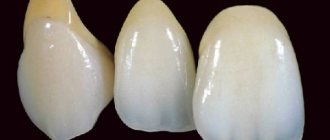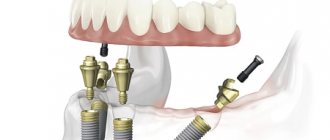Implantation is impossible without three-dimensional modeling.
Creating a 3D model allows you to obtain detailed information about the condition of the jaw and existing problems that may prevent the installation of implants. Based on this, a step-by-step implantation plan is developed and the placement of implants of the selected type is modeled. As an option, based on the results of three-dimensional diagnostics, a special implantation template is created, which is subsequently used when implanting implants.
In accordance with the treatment plan, it contains titanium cylinders through which the doctor will perforate the gums and bone. Using a template allows you to make the implantation bed exactly in the right place and at the right angle.
The result of the modeling is the final scheme for implanting an implant of a certain type, size and with a clearly planned location. Prosthetics are also planned. At the final stage, the data is transferred to the computer, and it grinds the frame of the bridge on implants in full accordance with the specified parameters.
3D in dentistry: what technologies are used?
The following 3D printing technologies are most often used in dentistry today:
- SLM. This is a laser melting technology for working with metal. It can be used to create braces and implants. A build plate is placed on the heated working platform of the printer, and metal powder is applied to the plate layer by layer. The laser beam scans sections of the layers. Once one layer is ready, the platform is lowered down to the thickness of one layer. This will be repeated until the last layer is printed.
- SLA. Laser stereolithography is used in areas where maximum precision of parts is important. The mesh platform is placed inside a container filled with liquid polymer. Under the influence of a laser, the polymer hardens in certain areas. The platform sinks down layer by layer. The finished print is placed in a bath with a special solution to remove unnecessary elements from it.
- LCD. The printer is equipped with a liquid crystal matrix through which light from LEDs passes. This matrix is similar to the one installed in smartphones we are used to. In this case, the luminous flux is dimmed by the display. Under the influence of a laser, the liquid photopolymer in the bath hardens layer by layer. Unlike SLA technology, the entire layer is illuminated instantly, and not at individual points, which significantly speeds up the printing process.
- LFS. Low power stereolithography is similar to SLA, but makes the printing process less complex and more economical. Formlabs has developed a unique light processing unit for this technology to achieve a flawless print surface. LFS printers can usually resume the printing process after a pause or unexpected stop without affecting the quality of the print.
ATTENTION. Trends in technology development are such that 3D printing is becoming less and less expensive and faster. Operating a printing device is becoming increasingly easier, and the accuracy and detail of finished prints is steadily increasing.
Here are examples of 3D printed dental products:
Photogrammetry
This technology stands somewhat apart from optical scanning. It offers high performance because it measures the image, not the object. Other benefits include:
- high accuracy;
- strict methods of processing measurement results;
- the ability to study stationary and moving objects;
- remote nature of measurements.
Monophotogrammetry with structured illumination is most often used. The latter represents a certain known pattern projected onto an object. To build a three-dimensional model, they take the distortion when projecting onto the object.
Application of 3D printing in dentistry
3D printing is in demand primarily among orthodontists, surgeons, and prosthetists. They appreciate the following advantages of this technology:
- The production of models, aligners, implants and other products requires significantly less time than with the traditional method of their production.
- Financial costs are reduced, material consumption is reduced.
- All objects are obtained as accurately as possible, corresponding to the anatomy and individual needs of the patient. The printing process is fully automated - the human factor, which causes most defects, has been eliminated.
- If the product needs to be corrected, it is enough to make adjustments to its computer model (which only takes a few minutes).
- The model that suits the client can be stored for years in the form of a computer file. There is no need to store physical samples.
- Production volumes can be increased without hiring additional personnel.
- Learning how to use a 3D printer and its software is relatively easy. A clinic employee does not have to delve into all the technological nuances that do not directly relate to dentistry - manufacturers of printing devices have reliable and competent technical support services.
ATTENTION: 3D technologies in dentistry still remain exotic in our country. The very fact of their use gives the clinic a significant marketing advantage.
What is the difference between 3D modeling and 4D implantation?
These are completely different technologies and should not be confused. Three-dimensional modeling allows you to plan the implantation process and predict its result. 4D implantation is one of the names of the basal technique, in which T-shaped implants are implanted into the jaw from the side.
| Expert, author of the article: Akhtanin Alexander Pavlovich Orthopedic dentist, implantologist 35 years of implantation experience Material updated: October 11, 2022 |
Aligners
The production of aligners in 3D occurs according to the following algorithm:
- The specialist makes a cast of the patient’s jaw from plaster and scans it. Alternatively, an impression can be taken using two-part silicone.
- In the software, based on a scan of the impression, the dentition in different states is modeled in phases: from the crooked position of the teeth to a perfectly straight smile.
- The file is sent for printing. Using the printed modified models, the aligners are vacuum formed.
The doctor checks the quality of the print and hands the aligners to the patient.
What are the benefits of 3D printing in the production of aligners?
3D printing is more profitable than traditional aligner production for at least three reasons:
- This is more economical from a financial point of view.
- Treatment can begin the very next day after the jaw impression is scanned.
- If the aligner turns out to be defective or deteriorates during use, it can be replaced literally in one day and with minimal expense.
For the patient, all this creates additional psychological comfort.
What equipment and software is needed to make aligners?
The following programs are most in demand for the production of aligners:
- 3D Shape. Functional and easy-to-use software, the only drawback of which is the need for an annual renewal of the paid license.
- Maestro 3d Ortho Studio. The license for this program is purchased only once, and then additional modules can be purchased for the software. Those options that were present in the program initially will remain available even if the user does not purchase new modules.
- "Avantis". This is Russian software whose license does not include a module for outputting .STL files. You will have to pay extra for this module separately.
ATTENTION. All these programs belong to the CAD category, that is, autonomous design systems.
Here's what the 3D printed aligners look like:
Bracket systems
With the traditional approach, the orthodontist places braces on each tooth as he sees fit. But the computer can perform a more accurate calculation and suggest on which part of the tooth it is optimal to place the brace. Using 3D technology, a tray is first printed, on which the bracket system is then placed. This approach allows you to increase the effectiveness of treatment and reduce the duration of wearing braces.
ATTENTION. Braces are gradually becoming a thing of the past, as they are too conspicuous, and their glue deteriorates tooth enamel. In the future, they will likely be completely replaced by aligners.
Virtual tooth preparation
3D visualization and planning provide information about the future shape of the tooth. Using it, you can design the shape of the future stump created by preparation, that is, perform “reverse planning”. To do this, the thickness of the future crown (framework and facing material) is taken from the shape of the tooth. Knowing the shape of the diamond bur for preparation, they set the trajectory of movement along the tooth to obtain the desired result.
Since the bur is secured in the handpiece in a unique way, the movement of the handpiece in relation to the dentition is easy to calculate. This can also be done with respect to three reference objects attached to the tip.
The next stage is designing a template, or mouthguard, to be fixed to the teeth. In the body of the mouth guard, it is necessary to virtually “subtract” the grooves according to known specified trajectories. The template is made by prototyping and is used to guide tooth preparation.
The technology could be widely used, but this has not yet happened, or at least it is not yet used for commercial purposes. The development belongs to the American company Origin (2012).
3D printer in dentistry for the production of implants for prosthetics
Today, surgical templates are successfully printed using 3D printers. They allow you to drill at exactly the right angle, ensure correct positioning of the implant and avoid complications. First, the patient comes to the doctor to take an impression and receive a referral for a CT scan. Implantation itself occurs in the second session.
Manufacturing of surgical templates
Templates must be made exclusively from solid transparent materials that can withstand high temperatures. They are usually modeled in the Implant Assistant program, which provides high-quality technical support in Russian.
Advantages of using surgical guides and main problems
When installing implants, an inexperienced doctor can harm the patient’s health if he accidentally:
- will drill at the wrong angle;
- will drill too deep or not deep enough;
- does not position the implant accurately.
In order for the bone tissue to recover after such an error, it sometimes takes up to 12 months to wait. If you make a template, the drilling will be done as accurately as possible. 3D printing can provide precision that is currently unattainable by any other cost-effective technology.
Dental models
Over 90% of models in dentistry today are made by hand. This is long, dirty, painstaking work that can never be compared to automated production in terms of accuracy.
Some components - for example, clasp dentures - can only be made by casting or 3D printing. It is impossible to use a cutter in this case, since the part is too thin. When casting, the probability of defects is too high; the product may turn out to be insufficiently elastic or strong. In 3D this risk is eliminated.
ATTENTION . Products printed on a 3D printer will always be homogeneous and monolithic. This is extremely important for crowns: if they turn out to be porous, the ceramics will begin to bounce off. A well-established printing process will avoid this undesirable consequence.
How is computer modeling carried out? What are the main steps of the procedure? What is the result?
Modeling is carried out according to a standard protocol in several stages:
- First, the entire jaw is scanned on a CT scan. Based on the data obtained, a 3D model of the patient’s jaws is created using a computer program.
- The implantologist conducts a thorough diagnosis, closely examining the bone tissue, measuring its height and width, determining whether it is sufficient to accommodate the selected type of implant.
- A virtual model of the jaw is created with implants of the selected type installed and a prosthesis placed on them. It is assessed whether the placement angle, length and type of structures are suitable. In this case, both the entire three-dimensional model and layer-by-layer frames—some sections—are taken into account.
- The equipment and protocol for the operation are selected, bone grafting and its predicted (instant and long-term) prospects are planned, if necessary.
As a result, 3D modeling provides a forecast for dental implantation, taking into account the physiological characteristics of the patient’s teeth and jaw tissue. This helps reduce the trauma of the operation and speeds up rehabilitation.
Which material to choose?
In the dental industry, the most popular filaments are from NextDent, Detax, HARZ Labs and Formlabs. In their extensive palettes, it is easy to choose the shade that perfectly matches the natural color of the patient’s gums and teeth.
NextDent (Holland)
The NextDent line of dental filaments includes 30 items, which is a record for the industry. All filaments from this manufacturer are biocompatible and certified. The cost of one package of the product averages 30,000 rubles.
Detax (Germany)
This brand’s line includes 13 filaments, each of which is recommended for use in creating a specific type of product: aligners, implants, jaw casts, and so on. The average cost of one package is 20,000 rubles.
HARZ Labs (Russia)
HARZ Labs' specialized line of products for dentists is called Dental. It contains the following types of filaments:
- for modeling surgical templates;
- to create demonstration models of temporary crowns and bridges;
- for creating demonstration dental models and master models;
- radiopaque polymer for the production of CT templates, facilitating the subsequent alignment of the scanned jaw with a computed tomogram;
- for the production of models used for direct casting;
- for the production of demonstration dental models of gums;
- for making transparent models.
The cost of one package of polymer is on average 12,000 rubles.
Formlabs (USA)
The Formlabs line of dental filaments includes 6 items intended for the production of:
- orthodontic and diagnostic models;
- templates and guides for drilling;
- night guards;
- cast crowns and removable denture frames;
- clear aligners and orthodontic models;
- trial and permanent dentures.
The average cost of one package is 15,000 rubles.
3D visualization solves the following problems:
- identifies objective aesthetic problems at the time of patient’s treatment;
- performs virtual modeling of the future shape and position of teeth;
- allows you to justify the treatment plan, for example, before installing a partial denture on the upper jaw, and the advisability of involving orthodontists or implant surgeons.
For design, standard tooth shapes from a data bank or the patient’s own teeth are used. Design tools - moving teeth, rotating, deforming and scaling individual parts.
Which 3D printer should a dentist choose?
The main requirements for a 3D printer for dentistry are high printing accuracy and flawless surface treatment of products. Dentists can use the same printer models as jewelers. However, some manufacturers produce printing devices that are initially focused on working with biomaterials.
Below are the technical characteristics and main advantages of four 3D printers, especially suitable for use in dentistry. All of them are distinguished by their compact dimensions, affordable cost and attractive design. The combination of a streamlined silhouette and bright colors is more reminiscent of household and kitchen utensils than of production processes. Such printers can be easily placed in the office of a small dental clinic.
Formlabs Form 3 3D printer
- Technology: LFS.
- Working surface dimensions: 145 mm × 145 mm × 185 mm.
- Weight: 17.5 kg.
- Layer thickness: from 25 microns.
- Printing accuracy: 25 microns in X and Y axes.
- Estimated cost: 340,000 rubles.
For Formlabs Form 3, a dedicated light processing unit has been developed with a compact lens and mirror system to ensure maximum accuracy and successful print repeatability. The 250 mW laser passes through a spatial filter, resulting in an exceptionally clean laser spot with a diameter of 85 µm. The parabolic mirror is responsible for the fact that printing is carried out strictly perpendicular to the plane of the platform.
Formlabs Form 3 3D printer
- Laser spot diameter 85 µm
- Laser wavelength 405 nm
- Laser 1x250 mW
- LFS stamp
- Working chamber area 145x145x185 mm
- Materials used Photopolymer
- Layer thickness from 25 microns
- Display Touch 5.5″ 1280 × 720
- Interfaces Wifi;Ethernet and USB
- Price 367,000 rub.
Go to product
The print scale and power are constantly adjusted by optical sensors, which can also detect dust. In order to switch from one polymer to another, the cartridges only need a few seconds. The user can change the optical window, rollers and light processing unit independently, without involving technical specialists. This greatly simplifies the process of operating and maintaining the printer.
Formlabs Form 3B 3D printer
- Technology: LFS.
- Dimensions of the working surface: 145 mm × 145 mm x × 185 mm.
- Weight: 17.5 kg.
- Layer thickness: from 25 microns.
- Printing accuracy: 25 microns in X and Y axes.
- Estimated cost: 385,000 rubles.
Formlabs Form 3B is new for 2022. This model differs from Formlabs Form 3 in that it was initially optimized for working with biocompatible materials. It uses the same advanced light processing unit, and the modular system ensures stability and easy scalability of production. According to the manufacturer, LFS technology allows you to create 2-3 times more prints in one go than DLP. Labor and time costs are reduced by up to 55% compared to DLP.
Formlabs Form 3B 3D printer
- Dimensions, mm 17.5
- FORMLABS PREFORM software
- Laser spot diameter 85 µm
- Laser wavelength 405 nm
- Material Photopolymer
- Laser power 250 mW
- LFS stamp
- X and Y resolution 25 µm
- Working chamber area 145x145x185 mm
- Layer thickness from 25 microns
- Display 5.5″ touch, 1280 × 720
- Interfaces Wi-Fi (2.4, 5 GHz), Ethernet (1000 Mbit), USB 2.0
- Price 420,000 rub.
Go to product
Formlabs has developed specialized filaments for each area of dentistry. They are supplied in convenient cartridges that the user can easily change independently. Form Wash and Form Cure post-processing tools ensure flawless print quality. Support requests are processed by staff who specialize specifically in the use of 3D printing in dentistry.
Phrozen Sonic Mini
- Technology: LCD.
- Working surface dimensions: 120 mm × 68 mm × 130 mm.
- Weight: 4.5 kg.
- Layer thickness: from 10 microns.
- Printing accuracy: 62 microns along the X and Y axes, 10 microns along the Z axis.
- Estimated cost: 32,900 rubles.
Phrozen Sonic Mini is considered a printer for hobbyists and beginners. It successfully compensates for its low resolution with more intense UV radiation, due to which the layers harden faster. The monochrome matrix of the device requires replacement every 2000 hours, and the RGB analogues, which provide higher resolution, have to be changed every 500 hours. In addition, the monochrome nature of the matrix ensures printing speeds of up to 50 mm/h.
Phrozen Sonic mini 3D printer
- Dimensions, mm 250x250x330
- Weight, kg 4.5
- UV wavelength 405 nm
- Light source UV LED 40 W
- LCD printing
- Supported software Chitubox, Phrozen OS
- Z-axis resolution 10 µm
- X and Y resolution 62 µm
- Working chamber area 120x68x130 mm
- Speed 50 mm/hour
- Layer thickness from 10 microns
- LCD display 5.5″ 1920×1080
- Interfaces USB, microSD
- Price 34,900 rub.
Go to product
The printer screen is durable, resistant to high temperatures and pressure. The device's energy consumption is extremely economical, only 35 W, so it did not require an active cooling system. During the printing process, the printer does not make noise or vibrate, so the dentist can safely place it on his desk next to the computer.
Finalization of the 3D model
Today, there are several options for printing dental prostheses, which differ in the type of material used, the method of forming the blank, and so on. Regardless of the option, increased demands are placed on the quality of the model. To do this, the layout is modified using special software. This can be general or specialized software. Rework is required to eliminate serious defects, improve quality and reduce the time required for post-processing immediately after installation of the prosthetic tooth. To improve quality, modern printers have support and special add-ons.
Printing cost calculation
Any new technology is doubly good if it also brings additional economic efficiency for users. Knowing the weight of the material required to create a particular model, you can calculate the cost of printing. For example, to create one demo model, you will need about 25 grams. resin, surgical template and aligner model - about 15 g.
Therefore, the cost of printing one model will be as follows:
- 25 gr. resin (for demo model) Dental Peach will cost you 190 rubles, 15 g. (models for aligners) – 115 rub.
- 15 gr. Dental Yellow Clear for templates will cost 150 rubles.
Based on this simple calculation, you can make a comparison with the methods of creating models that you use now, and understand how quickly you can return your investment in purchasing the equipment you need.
Post-processing
If you have already decided to purchase a 3D printer, then you should also consider the need for two additional devices: an ultrasonic cleaner and a UV illumination chamber .
After printing, models need post-processing; first of all, they need to be washed in industrial alcohol to remove residual resin. This can be done manually in a bath of alcohol, but it is best to use a special ultrasonic cleaner that copes with this task as quickly and efficiently as possible.
A UV camera is needed to additionally illuminate the model after printing; this also gives the model additional strength. You can put the model in the sun or in a household chamber to dry nails, but then this process will take from 12 to 24 hours; in a UV chamber it takes 10-15 minutes.
Our company has created special sets of equipment, which we call “dental solutions.” By purchasing such a set, you will receive an additional discount. If we talk about specific models, we recommend paying attention to the Wanhao Boxman-1 UV camera
and ultrasonic bath UNIZ UC-4120.

